JVC KD-G162, KD-G161, KD-G126, KD-G125, KD-G124 Service Manual
...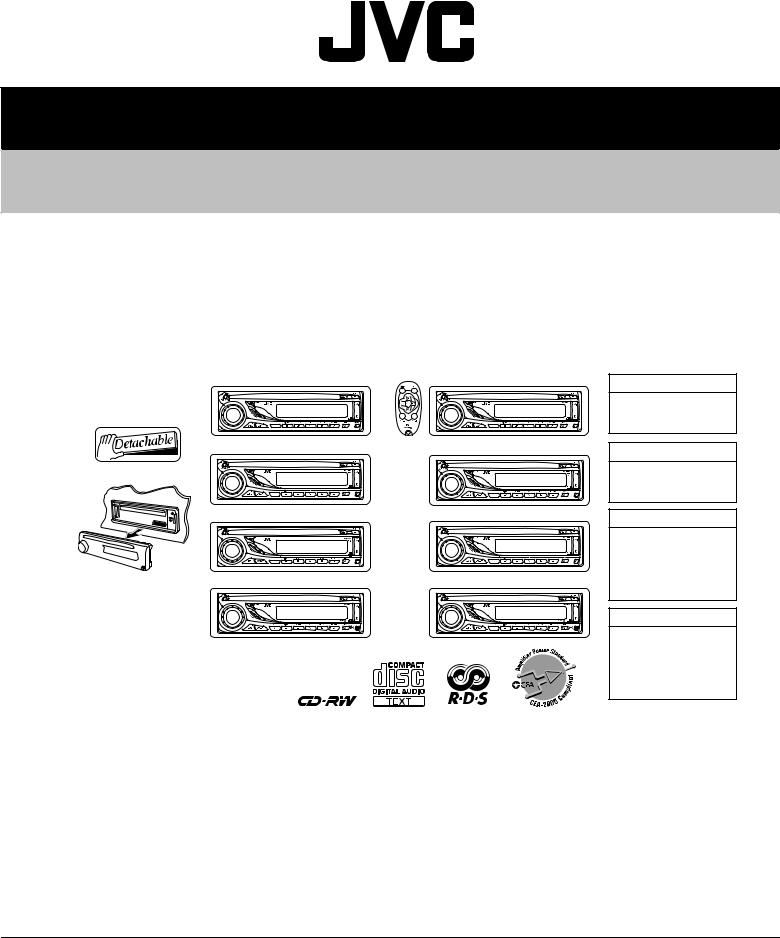
SERVICE MANUAL
CD RECEIVER
KD-G120,KD-G120R,KD-G123, KD-G124,KD-G125,KD-G126, KD-G161,KD-G162
KD-G120 |
KD-G120R |
|
KD-G120,KD-G120R |
|
|
|
|
||
|
|
|
Area suffix |
|
|
|
J ------------- |
Northern America |
|
KD-G123 |
KD-G124 |
|
KD-G123,KG-G124 |
|
|
|
|
||
|
|
|
Area suffix |
|
|
|
UI ---------------------------- |
India |
|
KD-G125 |
KD-G126 |
|
KD-G125,KD-G126 |
|
|
|
|
||
KD-G126 |
KD-G125 |
|
Area suffix |
|
|
|
|
||
|
|
UT |
------------------------- Taiwan |
|
|
|
UH |
---------------------- Thailand |
|
KD-G161 |
KD-G162 |
UN |
--------------------- Indonesia |
|
U |
Other Areas |
|||
|
|
|||
KD-G161 |
KD-G162 |
|
|
|
|
|
|
KD-G161,KD-G162 |
|
|
|
|
Area suffix |
|
|
|
E ------------- |
Southern Europe |
|
|
|
EX |
------------ Northern Europe |
|
|
|
EY |
------------- Eastern Europe |
|
|
|
EU |
------------------------- Turkey |
Lead free solder used in the board (material : Sn-Ag-Cu, melting point : 219 Centigrade)
TABLE OF CONTENTS
1 PRECAUTIONS . . . . . . . . . . . . . . . . . . . . . . . . . . . . . . . . . . . . . . . . . . . . . . . . . . . . . . . . . . . . . . . . . . . . . . . 1-6 2 SPECIFIC SERVICE INSTRUCTIONS . . . . . . . . . . . . . . . . . . . . . . . . . . . . . . . . . . . . . . . . . . . . . . . . . . . . . . 1-9 3 DISASSEMBLY . . . . . . . . . . . . . . . . . . . . . . . . . . . . . . . . . . . . . . . . . . . . . . . . . . . . . . . . . . . . . . . . . . . . . . 1-10 4 ADJUSTMENT . . . . . . . . . . . . . . . . . . . . . . . . . . . . . . . . . . . . . . . . . . . . . . . . . . . . . . . . . . . . . . . . . . . . . . . 1-13 5 TROUBLESHOOTING . . . . . . . . . . . . . . . . . . . . . . . . . . . . . . . . . . . . . . . . . . . . . . . . . . . . . . . . . . . . . . . . . 1-14
COPYRIGHT © 2005 Victor Company of Japan, Limited
No.MA233
2005/12

SPECIFICATION
KD-G120R/KD-G120
AUDIO AMPLIFIER SECTION
Power Output |
|
17 W RMS × 4 Channels at 4 Ω |
and [< or =] 1% THD+N |
||||
|
|
|
|
|
|
||
Signal to Noise Ratio |
|
80 dBA (reference: 1 W into 4 Ω |
) |
|
|
||
|
|
|
|
|
|
||
Load Impedance |
|
4 Ω (4 Ω to 8 Ω allowance) |
|
|
|
||
|
|
|
|
|
|
|
|
Tone Control Range |
Bass |
±10 dB at 100 Hz |
|
|
|
|
|
|
|
|
|
|
|
|
|
|
Treble |
±10 dB at 10 kHz |
|
|
|
|
|
|
|
|
|
|
|
|
|
Frequency Response |
|
40 Hz to 20 000 Hz |
|
|
|
|
|
|
|
|
|
|
|
||
Line-Out Level/Impedance |
|
2.0 V/20 kΩ load (full scale) |
|
|
|
||
|
|
|
|
|
|
|
|
Output Impedance |
|
1 kΩ |
|
|
|
|
|
|
|
|
|
|
|||
Subwoofer-Out Level/Impedance |
2.0 V/20 kΩ load (full scale) |
|
|
|
|||
|
|
|
|
|
|
|
|
|
TUNER SECTION |
|
|
|
|
||
|
|
|
|||||
Frequency Range |
FM |
87.5 MHz to 107.9 MHz (with channel interval set to 100 kHz or 200 kHz) |
|||||
|
|
87.5 MHz to 108.0 MHz (with channel interval set to 50 kHz) |
|||||
|
|
|
|||||
|
AM |
530 kHz to 1 710 kHz (with channel interval set to 10 kHz) |
|||||
|
|
531 kHz to 1 602 kHz (with channel interval set to 9 kHz) |
|||||
|
|
|
|
|
|
||
FM Tuner |
Usable Sensitivity |
11.3 dBf (1.0 µV/75 Ω ) |
|
|
|
||
|
|
|
|
|
|
||
|
50 dB Quieting Sensitivity |
16.3 dBf (1.8 µV/75 Ω ) |
|
|
|
||
|
|
|
|
|
|
|
|
|
Alternate Channel Selectivity (400 kHz) |
65 dB |
|
|
|
|
|
|
|
|
|
|
|
|
|
|
Frequency Response |
40 Hz to 15 000 Hz |
|
|
|
|
|
|
|
|
|
|
|
|
|
|
Stereo Separation |
35 dB |
|
|
|
|
|
|
|
|
|
|
|
|
|
|
Capture Ratio |
1.5 dB |
|
|
|
|
|
|
|
|
|
|
|
|
|
AM Tuner |
Sensitivity |
20 µV |
|
|
|
|
|
|
|
|
|
|
|
|
|
|
Selectivity |
35 dB |
|
|
|
|
|
|
|
|
|
|
|
|
|
|
CD PLAYER SECTION |
|
|
|
|
||
|
|
|
|
|
|
||
Type |
|
Compact disc player |
|
|
|
||
|
|
|
|||||
Signal Detection System |
|
Non-contact optical pickup (semiconductor laser) |
|||||
|
|
|
|
|
|
|
|
Number of channels |
|
2 channels (stereo) |
|
|
|
|
|
|
|
|
|
|
|
|
|
Frequency Response |
|
5 Hz to 20 000 Hz |
|
|
|
|
|
|
|
|
|
|
|
|
|
Dynamic Range |
|
96 dB |
|
|
|
|
|
|
|
|
|
|
|
|
|
Signal-to-Noise Ratio |
|
98 dB |
|
|
|
|
|
|
|
|
|
|
|
||
Wow and Flutter |
|
Less than measurable limit |
|
|
|
||
|
|
|
|
|
|
|
|
|
|
GENERAL |
|
|
|
|
|
|
|
|
|
|
|||
Power Requirement |
Operating Voltage |
DC 14.4 V (11 V to 16 V allowance) |
|
|
|||
|
|
|
|
|
|
|
|
Grounding System |
|
Negative ground |
|
|
|
|
|
|
|
|
|
|
|||
Allowable Operating Temperature |
0°C to +40°C (32°F to 104°F) |
|
|
|
|||
|
|
|
|
|
|
|
|
Dimensions (W × H × D) |
Installation Size (approx.) |
182 mm × |
52 mm × |
150 mm (7-3/16" × |
2-1/16" × |
5-15/16") |
|
|
|
|
|
|
|
|
|
|
Panel Size (approx.) |
188 mm × |
58 mm × |
11 mm (7-7/16" × |
2-5/16" × |
7/16") |
|
|
|
|
|
||||
Mass (approx.) |
|
1.2 kg (2.6 lbs) (excluding accessories) |
|
||||
|
|
|
|
|
|
|
|
Design and specifications are subject to change without notice.
1-2 (No.MA233)

KD-G124/KD-G123
AUDIO AMPLIFIER SECTION
Maximum Power Output |
Front |
50 W per channel |
|
|
|
|
|
|
|
|
|
|
Rear |
50 W per channel |
|
|
|
|
|
|
|
||
Continuous Power Output |
Front |
19 W per channel into 4 Ω |
, 40 Hz to 20 000 Hz at no more than 0.8% total har- |
||
(RMS) |
|
monic distortion. |
|
|
|
|
|
|
|
||
|
Rear |
19 W per channel into 4 Ω |
, 40 Hz to 20 000 Hz at no more than 0.8% total har- |
||
|
|
monic distortion. |
|
|
|
|
|
|
|||
Load Impedance |
|
4 Ω (4 Ω to 8 Ω allowance) |
|||
|
|
|
|
|
|
Tone Control Range |
Bass |
±10 dB at 100 Hz |
|
|
|
|
|
|
|
|
|
|
Treble |
±10 dB at 10 kHz |
|
|
|
|
|
|
|
|
|
Frequency Response |
|
40 Hz to 20 000 Hz |
|
|
|
|
|
|
|
|
|
Signal to Noise Ratio |
|
70 dB |
|
|
|
|
|
|
|||
Line-Out Level/Impedance |
|
2.0 V/20 kΩ load (full scale) |
|||
|
|
|
|
|
|
Output Impedance |
|
1 kΩ |
|
|
|
|
|
||||
Subwoofer-Out Level/Impedance |
2.0 V/20 kΩ load (full scale) |
||||
|
|
|
|
|
|
|
TUNER SECTION |
|
|
||
|
|
|
|
||
Frequency Range |
FM |
87.5 MHz to 108.0 MHz |
|
||
|
|
|
|
||
|
AM |
531 kHz to 1 602 kHz |
|
||
|
|
|
|
||
FM Tuner |
Usable Sensitivity |
11.3 dBf (1.0 µV/75 Ω ) |
|
||
|
|
|
|
||
|
50 dB Quieting Sensitivity |
16.3 dBf (1.8 µV/75 Ω ) |
|
||
|
|
|
|
|
|
|
Alternate Channel Selectivity (400 kHz) |
65 dB |
|
|
|
|
|
|
|
|
|
|
Frequency Response |
40 Hz to 15 000 Hz |
|
|
|
|
|
|
|
|
|
|
Stereo Separation |
35 dB |
|
|
|
|
|
|
|
|
|
|
Capture Ratio |
1.5 dB |
|
|
|
|
|
|
|
|
|
AM Tuner |
Sensitivity |
20 µV |
|
|
|
|
|
|
|
|
|
|
Selectivity |
35 dB |
|
|
|
|
|
|
|
|
|
|
CD PLAYER SECTION |
|
|
||
|
|
|
|
||
Type |
|
Compact disc player |
|
||
|
|
|
|||
Signal Detection System |
|
Non-contact optical pickup (semiconductor laser) |
|||
|
|
|
|
|
|
Number of channels |
|
2 channels (stereo) |
|
|
|
|
|
|
|
|
|
Frequency Response |
|
5 Hz to 20 000 Hz |
|
|
|
|
|
|
|
|
|
Dynamic Range |
|
96 dB |
|
|
|
|
|
|
|
|
|
Signal-to-Noise Ratio |
|
98 dB |
|
|
|
|
|
|
|||
Wow and Flutter |
|
Wow and Flutter: Less than measurable limit |
|||
|
|
|
|
|
|
|
|
GENERAL |
|
|
|
|
|
|
|||
Power Requirement |
Operating Voltage |
DC 14.4 V (11 V to 16 V allowance) |
|||
|
|
|
|
|
|
Grounding System |
|
Negative ground |
|
|
|
|
|
|
|
||
Allowable Operating Temperature |
0°C to +40°C |
|
|
||
|
|
|
|
|
|
Dimensions (W × H × D) |
Installation Size (approx.) |
182 mm × |
52 mm × |
150 mm |
|
|
|
|
|
|
|
|
Panel Size (approx.) |
188 mm × |
58 mm × |
11 mm |
|
|
|
|
|||
Mass (approx.) |
|
1.2 kg (excluding accessories) |
|||
|
|
|
|
|
|
Design and specifications are subject to change without notice.
(No.MA233)1-3

KD-G126/KD-G125
AUDIO AMPLIFIER SECTION
Maximum Power Output |
Front |
50 W per channel |
|
|
|
|
|
|
|
|
|
|
Rear |
50 W per channel |
|
|
|
|
|
|
|
||
Continuous Power Output |
Front |
19 W per channel into 4 Ω |
, 40 Hz to 20 000 Hz at no more than 0.8% total har- |
||
(RMS) |
|
monic distortion. |
|
|
|
|
|
|
|
||
|
Rear |
19 W per channel into 4 Ω |
, 40 Hz to 20 000 Hz at no more than 0.8% total har- |
||
|
|
monic distortion. |
|
|
|
|
|
|
|||
Load Impedance |
|
4 Ω (4 Ω to 8 Ω allowance) |
|||
|
|
|
|
|
|
Tone Control Range |
Bass |
±10 dB at 100 Hz |
|
|
|
|
|
|
|
|
|
|
Treble |
±10 dB at 10 kHz |
|
|
|
|
|
|
|
|
|
Frequency Response |
|
40 Hz to 20 000 Hz |
|
|
|
|
|
|
|
|
|
Signal to Noise Ratio |
|
70 dB |
|
|
|
|
|
|
|||
Line-Out Level/Impedance |
|
2.0 V/20 kΩ load (full scale) |
|||
|
|
|
|
|
|
Output Impedance |
|
1 kΩ |
|
|
|
|
|
||||
Subwoofer-Out Level/Impedance |
2.0 V/20 kΩ load (full scale) |
||||
|
|
|
|
|
|
|
TUNER SECTION |
|
|
||
|
|
|
|
||
Frequency Range |
FM |
87.5 MHz to 108.0 MHz |
|
||
|
|
|
|
||
|
AM |
531 kHz to 1 602 kHz |
|
||
|
|
|
|
||
FM Tuner |
Usable Sensitivity |
11.3 dBf (1.0 µV/75 Ω ) |
|
||
|
|
|
|
||
|
50 dB Quieting Sensitivity |
16.3 dBf (1.8 µV/75 Ω ) |
|
||
|
|
|
|
|
|
|
Alternate Channel Selectivity (400 kHz) |
65 dB |
|
|
|
|
|
|
|
|
|
|
Frequency Response |
40 Hz to 15 000 Hz |
|
|
|
|
|
|
|
|
|
|
Stereo Separation |
35 dB |
|
|
|
|
|
|
|
|
|
|
Capture Ratio |
1.5 dB |
|
|
|
|
|
|
|
|
|
AM Tuner |
Sensitivity |
20 µV |
|
|
|
|
|
|
|
|
|
|
Selectivity |
35 dB |
|
|
|
|
|
|
|
|
|
|
CD PLAYER SECTION |
|
|
||
|
|
|
|
||
Type |
|
Compact disc player |
|
||
|
|
|
|||
Signal Detection System |
|
Non-contact optical pickup (semiconductor laser) |
|||
|
|
|
|
|
|
Number of channels |
|
2 channels (stereo) |
|
|
|
|
|
|
|
|
|
Frequency Response |
|
5 Hz to 20 000 Hz |
|
|
|
|
|
|
|
|
|
Dynamic Range |
|
96 dB |
|
|
|
|
|
|
|
|
|
Signal-to-Noise Ratio |
|
98 dB |
|
|
|
|
|
|
|||
Wow and Flutter |
|
Less than measurable limit |
|||
|
|
|
|
|
|
|
|
GENERAL |
|
|
|
|
|
|
|||
Power Requirement |
Operating Voltage |
DC 14.4 V (11 V to 16 V allowance) |
|||
|
|
|
|
|
|
Grounding System |
|
Negative ground |
|
|
|
|
|
|
|
||
Allowable Operating Temperature |
0°C to +40°C |
|
|
||
|
|
|
|
|
|
Dimensions (W × H × D) |
Installation Size (approx.) |
182 mm × |
52 mm × |
150 mm |
|
|
|
|
|
|
|
|
Panel Size (approx.) |
188 mm × |
58 mm × |
11 mm |
|
|
|
|
|||
Mass (approx.) |
|
1.2 kg (excluding accessories) |
|||
|
|
|
|
|
|
Design and specifications are subject to change without notice.
1-4 (No.MA233)

KD-G162/KD-G161
AUDIO AMPLIFIER SECTION
Maximum Power Output |
Front |
45 W per channel |
|
|
|
|
|
|
|
|
|
|
Rear |
45 W per channel |
|
|
|
|
|
|
|
||
Continuous Power Output |
Front |
17 W per channel into 4 Ω |
, 40 Hz to 20 000 Hz at no more than 0.8% total har- |
||
(RMS) |
|
monic distortion. |
|
|
|
|
|
|
|
||
|
Rear |
17 W per channel into 4 Ω |
, 40 Hz to 20 000 Hz at no more than 0.8% total har- |
||
|
|
monic distortion. |
|
|
|
|
|
|
|||
Load Impedance |
|
4 Ω (4 Ω to 8 Ω allowance) |
|||
|
|
|
|
|
|
Tone Control Range |
Bass |
±10 dB at 100 Hz |
|
|
|
|
|
|
|
|
|
|
Treble |
±10 dB at 10 kHz |
|
|
|
|
|
|
|
|
|
Frequency Response |
|
40 Hz to 20 000 Hz |
|
|
|
|
|
|
|
|
|
Signal-to-Noise Ratio |
|
70 dB |
|
|
|
|
|
|
|||
Line-Out Level/Impedance |
|
2.0 V/20 kΩ load (full scale) |
|||
|
|
|
|
|
|
Output Impedance |
|
1 kΩ |
|
|
|
|
|
|
|
|
|
|
TUNER SECTION |
|
|
||
|
|
|
|
||
Frequency Range |
FM |
87.5 MHz to 108.0 MHz |
|
||
|
|
|
|||
|
AM |
(MW) 522 kHz to 1 620 kHz |
|||
|
|
(LW) 144 kHz to 279 kHz |
|
||
|
|
|
|
||
FM Tuner |
Usable Sensitivity |
11.3 dBf (1.0 µV/75 Ω ) |
|
||
|
|
|
|
||
|
50 dB Quieting Sensitivity |
16.3 dBf (1.8 µV/75 Ω ) |
|
||
|
|
|
|
|
|
|
Alternate Channel Selectivity (400 kHz) |
65 dB |
|
|
|
|
|
|
|
|
|
|
Frequency Response |
40 Hz to 15 000 Hz |
|
|
|
|
|
|
|
|
|
|
Stereo Separation |
30 dB |
|
|
|
|
|
|
|
|
|
|
Capture Ratio |
1.5 dB |
|
|
|
|
|
|
|
|
|
MW Tuner |
Sensitivity |
20 µV |
|
|
|
|
|
|
|
|
|
|
Selectivity |
35 dB |
|
|
|
|
|
|
|
|
|
LW Tuner |
Sensitivity |
50 µV |
|
|
|
|
|
|
|
|
|
|
CD PLAYER SECTION |
|
|
||
|
|
|
|
||
Type |
|
Compact disc player |
|
||
|
|
|
|||
Signal Detection System |
|
Non-contact optical pickup (semiconductor laser) |
|||
|
|
|
|
|
|
Number of Channels |
|
2 channels (stereo) |
|
|
|
|
|
|
|
|
|
Frequency Response |
|
5 Hz to 20 000 Hz |
|
|
|
|
|
|
|
|
|
Dynamic Range |
|
96 dB |
|
|
|
|
|
|
|
|
|
Signal-to-Noise Ratio |
|
98 dB |
|
|
|
|
|
|
|||
Wow and Flutter |
|
Less than measurable limit |
|||
|
|
|
|
|
|
|
|
GENERAL |
|
|
|
|
|
|
|||
Power Requirement |
Operating Voltage |
DC 14.4 V (11 V to 16 V allowance) |
|||
|
|
|
|
|
|
Grounding System |
|
Negative ground |
|
|
|
|
|
|
|
||
Allowable Operating Temperature |
0°C to +40°C |
|
|
||
|
|
|
|
|
|
Dimensions (W × H × D) |
Installation Size (approx.) |
182 mm × |
52 mm × |
150 mm |
|
|
|
|
|
|
|
|
Panel Size (approx.) |
188 mm × |
58 mm × |
11 mm |
|
|
|
|
|||
Mass (approx.) |
|
1.2 kg (excluding accessories) |
|||
|
|
|
|
|
|
Design and specifications are subject to change without notice.
(No.MA233)1-5

SECTION 1
PRECAUTIONS
1.1Safety Precautions
!


 Burrs formed during molding may be left over on some parts of the chassis. Therefore,
Burrs formed during molding may be left over on some parts of the chassis. Therefore,
pay attention to such burrs in the case of preforming repair of this system.
! |
Please use enough caution not to see the beam directly or touch it in case of an |
|
adjustment or operation check. |
|
|
1-6 (No.MA233)
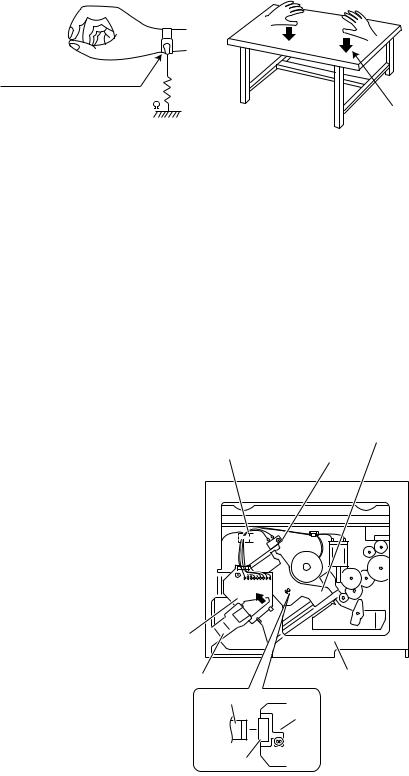
1.2Preventing static electricity
Electrostatic discharge (ESD), which occurs when static electricity stored in the body, fabric, etc. is discharged, can destroy the laser diode in the traverse unit (optical pickup). Take care to prevent this when performing repairs.
1.2.1Grounding to prevent damage by static electricity
Static electricity in the work area can destroy the optical pickup (laser diode) in devices such as CD players. Be careful to use proper grounding in the area where repairs are being performed.
(1)Ground the workbench
Ground the workbench by laying conductive material (such as a conductive sheet) or an iron plate over it before placing the traverse unit (optical pickup) on it.
(2)Ground yourself
Use an anti-static wrist strap to release any static electricity built up in your body.
(caption)
Anti-static wrist strap
1M
Conductive material (conductive sheet) or iron plate
(3)Handling the optical pickup
•In order to maintain quality during transport and before installation, both sides of the laser diode on the replacement optical pickup are shorted. After replacement, return the shorted parts to their original condition.
(Refer to the text.)
•Do not use a tester to check the condition of the laser diode in the optical pickup. The tester's internal power source can easily destroy the laser diode.
1.3Handling the traverse unit (optical pickup)
(1)Do not subject the traverse unit (optical pickup) to strong shocks, as it is a sensitive, complex unit.
(2)Cut off the shorted part of the flexible cable using nippers, etc. after replacing the optical pickup. For specific details, refer to the replacement procedure in the text. Remove the anti-static pin when replacing the traverse unit. Be careful not to take too long a time when attaching it to the connector.
(3)Handle the flexible cable carefully as it may break when subjected to strong force.
(4)It is not possible to adjust the semi-fixed resistor that adjusts the laser power. Do not turn it.
1.4Attention when traverse unit is decomposed
*Please refer to "Disassembly method" in the text for the CD pickup unit.
•Apply solder to the short land before the flexible wire is disconnected from the connector on the CD pickup unit. (If the flexible wire is disconnected without applying solder, the CD pickup may be destroyed by static electricity.)
•In the assembly, be sure to remove solder from the short land after connecting the flexible wire.
|
|
|
|
|
|
Pickup |
Wires |
|
|
|
Push switch |
||
|
|
|
|
|
|
|
|
|
|
|
|
|
|
|
|
|
|
|
|
|
|
|
|
|
|
|
|
|
|
|
|
|
|
|
Base board
Frame |
CD mechanism |
|
assembly |
||
Flexible wire |
||
|
||
|
Pickup |
|
Connector |
|
(No.MA233)1-7
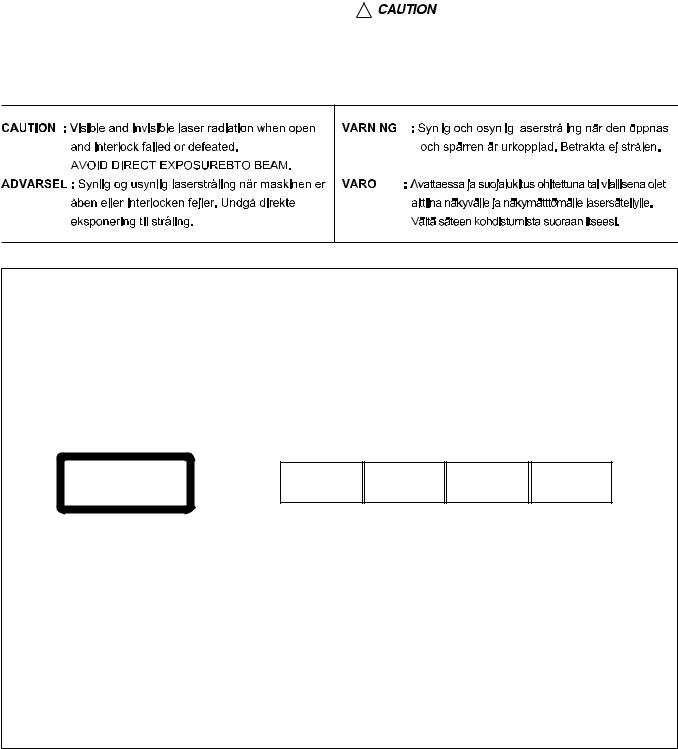
1.5Important for laser products
1.CLASS 1 LASER PRODUCT
2.DANGER : Invisible laser radiation when open and inter lock failed or defeated. Avoid direct exposure to beam.
3.CAUTION : There are no serviceable parts inside the Laser Unit. Do not disassemble the Laser Unit. Replace the complete Laser Unit if it malfunctions.
4.CAUTION : The CD,MD and DVD player uses invisible laser radiation and is equipped with safety switches which prevent emission of radiation when the drawer is open and the safety interlocks have failed or are defeated. It is dangerous to defeat the safety switches.
5.CAUTION : If safety switches malfunction, the laser is able
to function.
6.CAUTION : Use of controls, adjustments or performance of procedures other than those specified here in may result in hazardous radiation exposure.
! |
|
Please use enough caution not to |
|||
|
|
see the beam directly or touch it |
|||
|
|
in case of an adjustment or operation |
|||
|
|
check. |
|||
|
|
|
|
|
|
|
|
|
|
|
|
|
|
|
|
|
|
REPRODUCTION AND POSITION OF LABELS
WARNING LABEL
CLASS 1
LASER PRODUCT
CAUTION : Visible and Invisible laser radiation when open and interlock failed or defeated. AVOID DIRECT EXPOSURE TO BEAM. (e)
ADVARSEL : Synlig og usynlig laserstråling når maskinen er åben eller interlocken fejeler. Undgå direkte eksponering til stråling. (d)
VARNING : Synlig och osynling laserstrålning när den öppnas och spärren är urkopplad. Betrakta ej strålen. (s)
VARO : Avattaessa ja suojalukitus ohitettuna tai viallisena olet alttiina näkyvälle ja näkymättömälle lasersäteilylle. Vältä säteen kohdistumista suoraan itseesi. (f)
1-8 (No.MA233)
SECTION 2
SPECIFIC SERVICE INSTRUCTIONS
2.1CD mechanism
For the CD mechanism, please refer mechanism manual TN2007-1001 (No. MY003).
(No.MA233)1-9
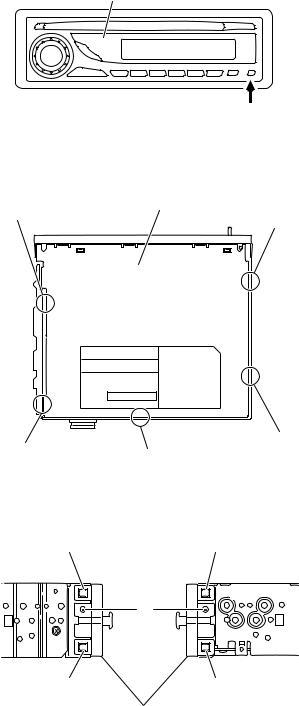
SECTION 3
DISASSEMBLY
3.1Main body section
3.1.1Removing the front panel assembly (See Fig.1)
(1)Push the detach button in the lower right part of the front panel assembly and remove the front panel assembly.
3.1.2 Removing the bottom cover (See Fig.2)
(1)Turn the main body up side down.
(2)Insert a screwdriver under the joints to release the two
joints a on the left side, two joints b on the right side and |
Joint a |
joint c on the back side of the main body, then remove the |
|
bottom cover from the main body. |
|
Note: |
|
When releasing the joints using a screwdriver, do not damage |
|
the main board. |
|
Joint a
3.1.3Removing the front chassis assembly (See Fig.3)
•Remove the front panel assembly and bottom cover.
(1)Remove the two screws A on the both sides of the main body.
(2)Release the two joints d and two joints e on the both sides of the main body, then remove the front chassis assembly toward the front.
Front panel assembly
Detach button
Fig.1
Bottom cover
Joint b
Joint b
Joint c
Fig.2
Joint d |
Joint e |
A
Joint d Joint e
Front chassis assembly
Fig.3
1-10 (No.MA233)
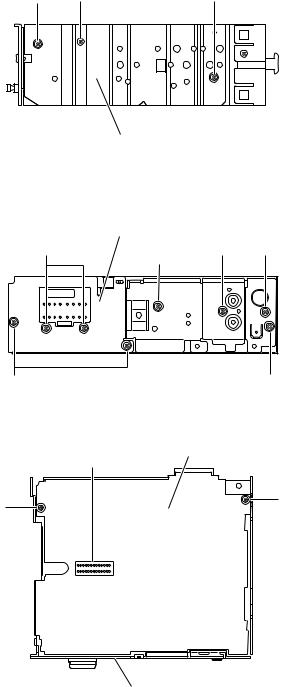
3.1.4Removing the side panel (See Fig.4)
Reference:
Remove the front panel assembly as required.
(1)Remove the screw B and two screws C attaching the side panel on the left side of the main body.
(2)Remove the side panel from the main body.
3.1.5 Removing the rear bracket (See Fig.5)
•Remove the bottom cover.
(1)Remove the three screws D, three screws E and two screws F attaching the rear bracket on the back side of the main body.
(2)Remove the rear bracket.
3.1.6 Removing the main board (See Figs.5 and 6)
•Remove the front panel assembly, bottom cover and side panel.
Reference:
Remove the front chassis assembly as required.
(1)Remove the three screws D attaching the rear bracket on the back side of the main body. (See Fig.5.)
(2)Remove the two screws G attaching the main board. (See Fig.6.)
(3)Disconnect the connector CN501 on the main board from the main body and take out the main board with the rear bracket. (See Fig.6.)
Reference:
Remove the rear bracket from the main body as required. (See "3.1.5 Removing the rear bracket".)
C B C
Side panel
Fig.4
Rear bracket
E E F
F
D |
D |
|
Fig.5 |
|
Main board |
|
CN501 |
G |
G |
|
Rear bracket
Fig.6
(No.MA233)1-11

3.1.7 Removing the CD mechanism assembly (See Fig. 7)
•Remove the front panel assembly, bottom cover, side panel, rear bracket and main board.
Reference:
Remove the front chassis assembly as required.
(1)Remove the three screws H attaching the CD mechanism assembly on the top chassis.
(2)Take out the CD mechanism assembly.
3.1.8Removing the switch board (See Figs.8 to 10)
•Remove the front panel assembly.
(1)Remove the four screws J on the back side of the front panel assembly. (See Fig.8.)
(2)Release the joints f and remove the rear cover. (See Fig.9.)
(3)Release the joint g and take out the switch board from the front panel assembly. (See Fig.10.)
H
CD mechanism assembly |
Top chassis |
H
Fig.7
J
J J
Fig.8
Joints f
Rear cover
|
|
|
|
|
|
|
|
|
|
|
|
|
|
|
|
|
|
|
|
|
|
|
|
|
|
|
|
|
|
|
|
|
|
|
|
|
|
|
|
|
|
|
|
|
|
|
|
|
|
|
|
|
|
|
|
|
|
|
|
|
|
|
|
|
|
|
|
|
|
|
|
|
|
|
Joints f |
|
|
Joints f |
|
|
|
Joints f |
|
|
|||||
Fig.9
Front panel assembly
Switch board |
Joint g |
Fig.10
1-12 (No.MA233)
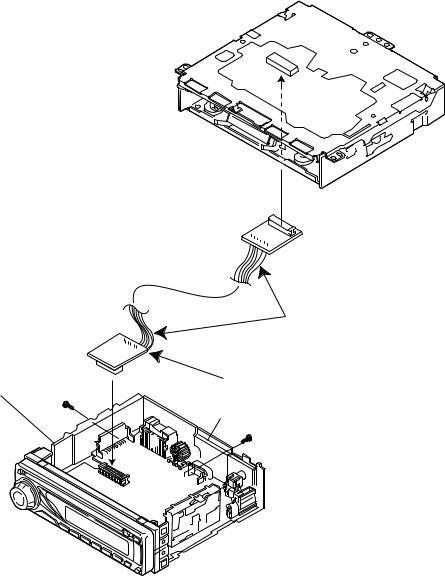
SECTION 4 ADJUSTMENT
4.1Adjustment method
Test instruments required for adjustment
(1)Digital oscilloscope (100MHz)
(2)Electric voltmeter
(3)Digital tester
(4)Tracking offset meter
(5)Test Disc JVC :CTS-1000
(6)Extension cable for check EXTSH002-22P × 1
Standard volume position
Balance and Bass &Treble volume : lndication"0" Loudness : OFF
Standard measuring conditions
Power supply voltage |
DC14.4V(10.5 to 16V) |
Load impedance |
20KΩ (2 Speakers connection) |
Output Level |
Line out 2.0V (Vol. MAX) |
Dummy load
Exclusive dummy load should be used for AM,and FM. For FM dummy load,there is a loss of 6dB between SSG output and antenna input.The loss of 6dB need not be considered since direct reading of figures are applied in this working standard.
How to connect the extension cable for adjusting
Caution:
Be sure to attach the heat sink and rear bracket onto the power amplifier IC and regulator IC respectively, before supply the power. If voltage is applied without attaching these parts, the power amplifier IC and regulator IC will be destroyed by heat.
CAUTION :
Be sure to attach the heat sink and rear bracket onto the power amplifier and regulator respectively, before supply the power.
If voltage is applied without attaching those parts, the power amplifier IC and regulator IC will be destroyed by heat.
Extension cable
Heat sink |
EXTSH002-22P |
|
|
|
Rear bracket |
(No.MA233)1-13
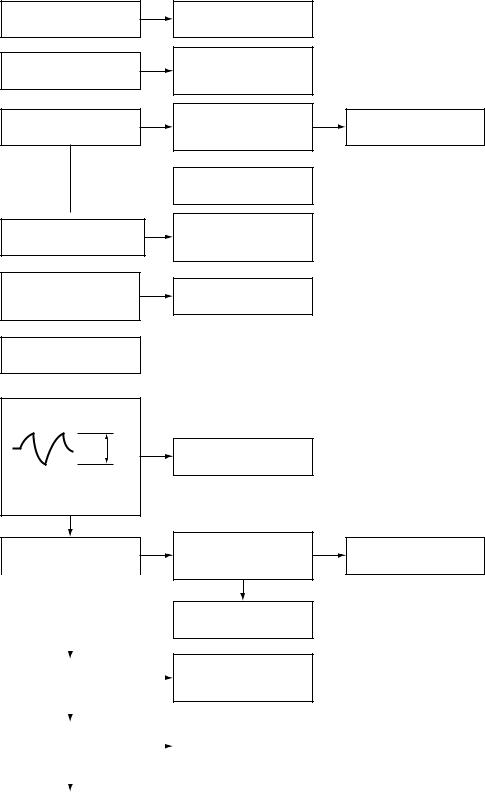
SECTION 5
TROUBLESHOOTING
5.1Trouble shooting (For KD-G120, KD-G120R, KD-G123, KD-G124,KD-G125 and KD-G126)
5.1.1 Feed section
Is 4V present at both sides of the feed motor?
 NO
NO
Is the voltage output at pin 4 and pin 5 of IC541?
 NO
NO
Is the voltage input at pin 28 of IC541?
 NO
NO
Is the voltage output at pin 21 and pin 22 of IC561?
 NO
NO
Is the power supply present at pin 4, pin 50, pin 60 and pin 72 of IC561?
 NO
NO
Check the connections of CD8V power supply.
5.1.2 Focus section
YES
YES
YES
YES
YES
Check the feed motor.
Check the connections between the feed motor and IC541.
Is the power supply present at pin 3, pin 12 and pin 21 of IC541?
 NO
NO
Check the connections of CD8V power supply.
Check the connections between IC541 and IC561.
Check IC561.
When the lens is moving:
4V YES
Does the S-search waveform appear at IC541 pins 8 and 9?
NO
Is the voltage input at pin YES 15 of IC541?
|
NO |
|
|
|
|
YES |
|
Is the voltage output at |
|||
|
|||
pin 28 of IC561? |
|
||
|
|
|
|
|
NO |
|
|
Check the pickup and its connections.
Is the power supply present at pin 3, pin 12 and pin 21 of IC541?
NO
Check the connections of CD8V power supply.
Check the connections between IC541 and IC561.
YES
Check IC541.
YES
Check IC541.
Is the power supply |
YES |
|
|||
|
|||||
present at pin 4, pin 50, |
Check IC561. |
||||
|
|
||||
|
|||||
pin 60 and pin 72 of IC561? |
|
|
|
||
|
|
|
|
|
|
|
NO |
|
|
|
|
|
|
|
|
||
Check the connections |
|
|
|
||
of CD8V power supply. |
|
|
|
||
|
|
|
|
|
|
1-14 (No.MA233)
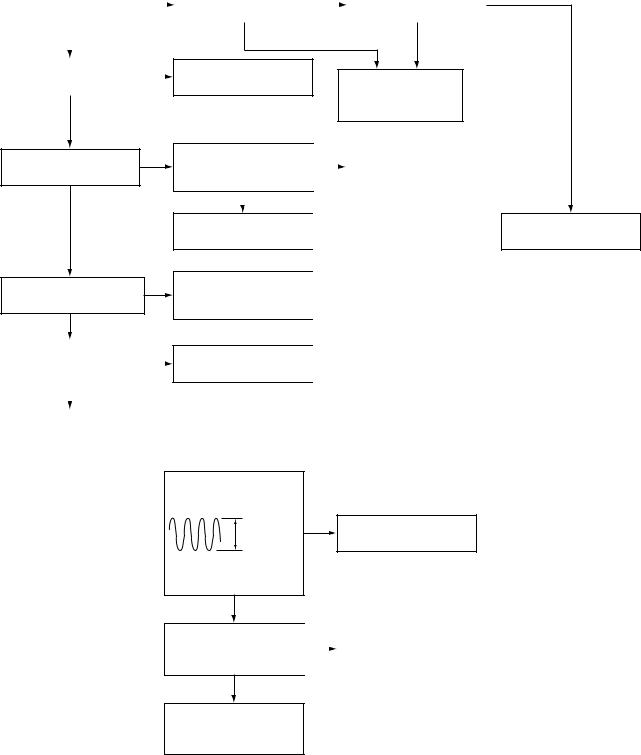
5.1.3 Spindle section |
|
|
|
|
|
|
|
|
|
YES |
|
YES |
|
||
|
Is the disk rotated? |
Does the RF signal |
Is the RF waveform |
||||
|
|
|
|
|
|||
|
|
|
appear at RF TP? |
|
|
at TP RF distorted? |
|
|
|
|
|
|
|
||
|
|
|
|
|
|
|
|
|
NO |
|
|
|
|
|
YES |
||
Is the voltage output at |
||||
|
|
|||
pin 6 and pin 7 of IC541? |
|
|
||
|
|
|
|
|
NO
Is the voltage input at pin YES 17 of IC541?
NO
Is the voltage output at pin YES 24 and pin 25 of IC561?
NO
|
Is the power supply |
YES |
|
|
present at pin 4, pin 50, |
||
|
|
||
|
|
||
|
pin 60 and pin 72 of IC561? |
|
|
|
|
|
|
|
|
NO |
|
|
|
|
|
|
Check the connections |
|
|
|
of CD8V power supply. |
|
|
|
|
|
|
5.1.4 Tracking section |
|
||
NO NO
Check the spindle motor
and its wiring. Check the circuits in the vicinity of IC501
or the pickup.
Is the power supply |
YES |
|
|||
Check IC541. |
|||||
present at pin 3, pin 12 |
|
|
|||
|
|||||
and pin 21 of IC541? |
|
|
|
||
|
|
|
|||
|
NO |
|
|
|
|
Check the connections |
|
|
|
||
|
|
|
|||
of CD8V power supply. |
|
|
|
||
Check the connections |
|
|
|
||
|
|
|
|||
between IC541 and |
|
|
|
||
IC561. |
|
|
|
||
|
|
|
|
||
Check IC561. |
|
|
|
||
|
|
|
|
|
|
When the disc is rotated at first:
Approx. 1.2V
Is the tracking error signal output at TE TP?
NO
Check the circuits in IC501 or the vicinity of IC501.
NO
Replace IC501 or repair the malfunction connection point
YES
Check IC561.
YES |
|
||
Check the pickup and |
|||
|
|
||
|
|
its connections. |
|
|
|
|
|
|
|
|
|
YES
Proceed to the Tracking section
(No.MA233)1-15

5.1.5 Signal processing section
Is the sound output from |
YES |
|
both channels (L, R)? |
|
Normal |
|
||
|
|
|
|
|
|
NO
No sound from either channel.
NO
Compare the L-ch and R-ch to locate the defective point.
|
|
|
|
|
|
|
|
Is the audio signal |
|
|
|
|
|
|
|
|
|
|
YES |
|
|
YES |
(including sampling |
YES |
Is the audio signal output |
|
|||||||||
|
Is 9V present at pin 26 |
|
|||||||||||||||
|
|
|
|
|
|
output components) |
|
|
at pin 22 and pin 25 of |
|
|||||||
|
|
|
of IC301? |
|
|
|
|
|
|
||||||||
|
|
|
|
|
|
output to pins 1 and 7 of |
|
|
IC301 during playback? |
|
|||||||
|
|
|
|
|
|
|
|
|
|
|
|||||||
|
|
|
|
|
|
|
|
IC151 during playback? |
|
|
|
|
|
|
|
|
|
|
|
|
|
|
|
|
|
|
|
|
|
|
|
|
|
||
|
|
|
|
|
|
|
|
|
|
|
|
|
|
|
|
|
|
|
|
|
|
|
|
|
|
|
NO |
|
|
|
|
NO |
|||
|
|
|
|
|
|
|
|
|
|
|
|
|
|
|
|
||
|
|
|
|
|
|
|
|
Check IC151 and its |
|
|
Check IC301 and its |
|
|||||
|
|
|
|
|
|
|
|
peripheral circuits. |
|
|
peripheral circuits. |
|
|||||
|
|
|
|
NO |
|
|
|
|
|
|
|
|
|
|
|
|
|
|
|
|
|
|
|
|
|
|
|
|
|
|
|
|
|
|
|
|
|
|
|
|
|
|
|
|
|
|
|
|
|
|
|
|
|
|
|
|
Is 9V present at pin 10 |
YES |
Check the connections |
|
|
|
|
|
YES |
||||||
|
|
|
|
|
|
|
|
||||||||||
|
|
|
of IC901? |
|
|
|
between pin 26 of IC301 |
|
|
|
Check the power |
||||||
|
|
|
|
|
|
and pin 10 of IC901. |
|
|
|
||||||||
|
|
|
|
|
|
|
|
|
|
|
amplifier IC321. |
||||||
|
|
|
|
NO |
|
|
|
|
|
|
|
|
|
|
|
|
|
|
|
|
|
|
|
|
|
|
|
|
|
|
|
|
|
||
|
|
|
|
|
|
|
|
|
|
|
|
|
|
|
|
|
|
|
|
|
Check IC901 and its |
|
|
|
|
|
|
|
|
|
|
|
|
|
|
|
|
|
peripheral circuits. |
|
|
|
|
|
|
|
|
|
|
|
|
|
|
|
|
|
|
|
|
|
|
|
|
|
|
|
|
|
|
|
|
1-16 (No.MA233)
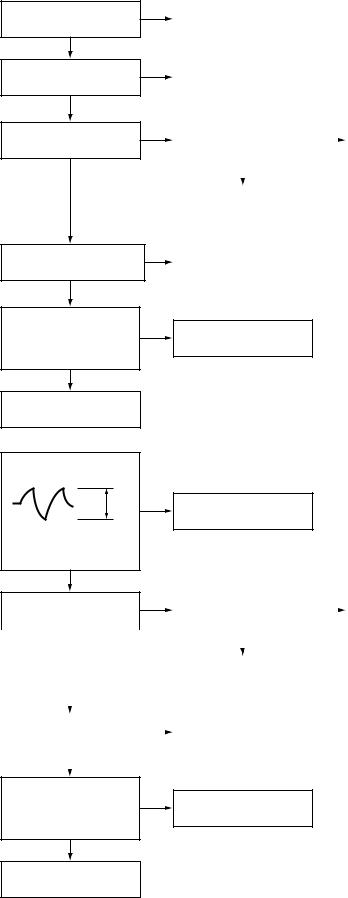
5.2Trouble shooting (For KD-G161 and KD-G162)
5.2.1 Feed section
Is 4V present at both sides of the feed motor?
NO
Is the voltage output at pin 4 and pin 5 of IC501?
NO
Is the voltage input at pin 28 of IC501?
NO
Is the voltage output at pin 7 of IC521?
NO
YES
YES
YES
YES
Check the feed motor. |
|
|
|
|
|
|
|
|
|
|
|
|
|
|
Check the connections |
|
|
|
|
between the feed motor |
|
|
|
|
and IC501. |
|
|
|
|
|
|
|
|
|
|
|
|
|
|
Is the power supply |
|
|||
YES |
Check IC501. |
|||
present at pin 3, pin 12 |
|
|
||
|
||||
and pin 21 of IC501? |
|
|
|
|
|
|
|
||
|
NO |
|
|
|
|
|
|
|
|
Check the connections |
|
|
|
|
of CD8V power supply. |
|
|
|
|
|
|
|
|
|
|
|
|
|
|
Check the connections |
|
|
|
|
between IC501 and |
|
|
|
|
IC521. |
|
|
|
|
|
|
|
|
|
Is the power supply
present at pin 16, pin 37, YES pin 49, pin 53, pin 56
and pin 72 of IC521?
NO
Check the connections of CD8V power supply.
5.2.2 Focus section
When the lens is moving:
4V YES
Does the S-search waveform appear at IC501 pins 8 and 9?
NO
Is the voltage input at pin YES 15 of IC501?
|
NO |
|
|
|
|
YES |
|
Is the voltage output at |
|||
|
|||
pin 13 of IC521? |
|
||
|
|
|
|
|
NO |
|
|
Check IC521.
Check the pickup and its connections.
Is the power supply |
YES |
|
|||
Check IC501. |
|||||
present at pin 3, pin 12 |
|
|
|||
|
|||||
and pin 21 of IC501? |
|
|
|
||
|
|
|
|||
|
NO |
|
|
|
|
|
|
|
|
||
Check the connections |
|
|
|
||
of CD8V power supply. |
|
|
|
||
|
|
|
|
|
|
|
|
|
|
|
|
Check the connections |
|
|
|
||
between IC501 and |
|
|
|
||
IC521. |
|
|
|
||
|
|
|
|
|
|
Is the power supply
present at pin 16, pin 37, YES
Check IC521.
pin 49, pin 53, pin 56 and pin 72 of IC521?
NO
Check the connections of CD8V power supply.
(No.MA233)1-17
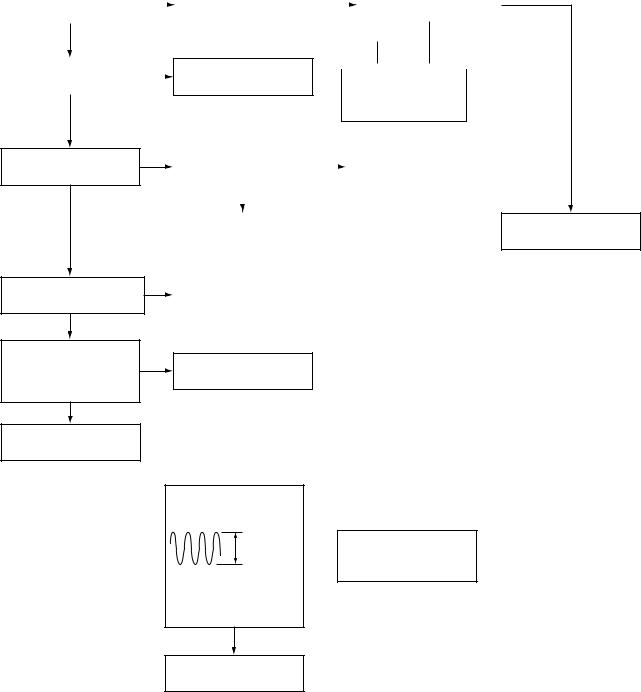
5.2.3 Spindle section |
|
|
|
|
|
|
|||
|
|
YES |
|
|
YES |
|
|
||
|
Is the disk rotated? |
Does the RF signal appear |
Is the RF waveform at |
||||||
|
|
|
at pin 39 of IC521? |
|
|
pin 39 of IC521 distorted? |
|||
|
|
|
|
|
|
||||
|
|
|
|
|
|
|
|
|
|
|
|
|
|
|
|
|
|
|
|
NO |
|
|
|
|
YES |
||
Is the voltage output at |
|||
|
|
||
pin 6 and pin 7 of IC501? |
|
|
|
|
|
|
|
NO
Is the voltage input at pin YES 17 of IC501?
NO
Is the voltage output at YES pin 5 of IC521?
NO
NO NO
Check the spindle motor  and its wiring. Check the circuits in
and its wiring. Check the circuits in
the vicinity of IC521 or the pickup.
Is the power supply |
YES |
|
|||
Check IC501. |
|||||
present at pin 3, pin 12 |
|
|
|||
|
|||||
and pin 21 of IC501? |
|
|
|
||
|
|
|
|||
|
NO |
|
|
|
|
|
|
|
|
||
Check the connections |
|
|
|
||
of CD8V power supply. |
|
|
|
||
|
|
|
|
|
|
|
|
|
|
|
|
Check the connections |
|
|
|
||
between IC501 and |
|
|
|
||
IC521. |
|
|
|
||
|
|
|
|
|
|
Is the power supply
present at pin 16, pin 37, YES
Check IC521.
pin 49, pin 53, pin 56 and pin 72 of IC521?
NO
Check the connections of CD8V power supply.
5.2.4 Tracking section
When the disc is rotated at first:
Approx. 1.2V YES Replace IC521 or repair
 the malfunction
the malfunction
connection point
Is the tracking error signal output at pin 26 of IC521?
NO
Check the pickup and its connections.
YES
Proceed to the Tracking section
1-18 (No.MA233)

5.2.5 Signal processing section
Is the sound output from |
YES |
|
both channels (L, R)? |
|
Normal |
|
||
|
|
|
|
|
|
NO
No sound from either channel.
NO
Compare the L-ch and R-ch to locate the defective point.
|
|
|
|
|
|
|
|
Is the audio signal |
|
|
|
|
|
|
|
|
|
|
|
|
|
|
|
|
|
|
|
|
Is the audio signal output |
|
|||||||
|
YES |
|
|
YES |
(including sampling |
YES |
|
|||||||||||
|
Is 9V present at pin 32 |
at pin 14,pin 15, pin 18 |
|
|||||||||||||||
|
|
|
of IC171? |
|
|
|
output components) |
|
|
and pin 19 of IC171 during |
|
|||||||
|
|
|
|
|
|
|
|
|
||||||||||
|
|
|
|
|
|
output to pins 1 and 7 of |
|
|
|
|||||||||
|
|
|
|
|
|
|
|
|
|
playback? |
|
|||||||
|
|
|
|
|
|
|
|
IC581 during playback? |
|
|
|
|||||||
|
|
|
|
|
|
|
|
|
|
|
|
|
|
|
|
|
||
|
|
|
|
|
|
|
|
|
|
|
|
|
|
|
|
|
|
|
|
|
|
|
|
|
|
|
|
NO |
|
|
|
|
|
NO |
|||
|
|
|
|
|
|
|
|
|
|
|
|
|
|
|
|
|
|
|
|
|
|
|
|
|
|
|
Check IC581 and its |
|
|
|
Check IC171 and its |
|
|||||
|
|
|
|
|
|
|
|
peripheral circuits. |
|
|
|
peripheral circuits. |
|
|||||
|
|
|
|
NO |
|
|
|
|
|
|
|
|
|
|
|
|
|
|
|
|
|
|
|
|
|
|
|
|
|
|
|
|
|
|
|
|
|
|
|
|
|
|
|
|
|
|
|
|
|
|
|
|
|
|
|
|
|
|
|
Is 9V present at pin 13 |
YES |
Check the connections |
|
|
|
|
|
|
YES |
||||||
|
|
|
|
|
|
|
|
|
||||||||||
|
|
|
of IC901? |
|
|
|
between pin 32 of IC171 |
|
|
|
|
Check the power |
||||||
|
|
|
|
|
|
and pin 13 of IC901. |
|
|
|
|
||||||||
|
|
|
|
|
|
|
|
|
|
|
|
amplifier IC301. |
||||||
|
|
|
|
NO |
|
|
|
|
|
|
|
|
|
|
|
|
|
|
|
|
|
|
|
|
|
|
|
|
|
|
|
|
|
|
|
|
|
|
|
|
Check IC901 and its |
|
|
|
|
|
|
|
|
|
|
|
|
|
|
|
|
|
|
peripheral circuits. |
|
|
|
|
|
|
|
|
|
|
|
|
|
|
|
|
|
|
|
|
|
|
|
|
|
|
|
|
|
|
|
|
|
|
(No.MA233)1-19
